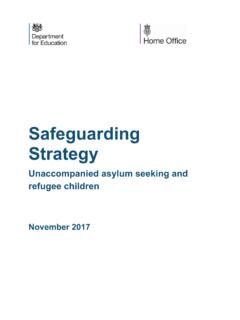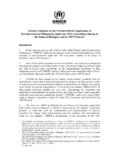Transcription of The Experiences and Needs of Refugee and Asylum …
1 R ESEARCH. The Experiences and Needs of Refugee and Asylum seeking Children in the UK: A Literature Review National Evaluation of the Children's Fund University of Birmingham Rachel Hek Research Report RR635. Research Report No 635. The Experiences and Needs of Refugee and Asylum seeking Children in the UK: A Literature Review National Evaluation of the Children's Fund University of Birmingham Rachel Hek The views expressed in this report are the authors' and do not necessarily reflect those of the Department for Education and Skills. University of Birmingham 2005. ISBN 1 84478 457 6. ii i Contents Section 1 Introduction Overview, key terms, concepts and review strategy 1. Section 2 Background and context 5. Section 3 Immigration 16. Section 4 Health 21.
2 Section 5 Education 29. Section 6 Family and Social Relationships 39. Section 7 Provision of Social Services 45. Section 8 Summary and gaps identified 55. References 61. ii iii Section 1- Introduction Overview, key terms, concepts and review strategy. The aim of this review is to consider the published literature in relation to the Experiences and Needs of Refugee children and young people in the UK over the last ten years. This is to provide an overview of the issues for this group of children and young people and the availability, accessibility and types of preventative services that attempt to meet their Needs . It is hoped that this information can then be used by anyone who has an interest in the provision of services or who wishes to identify where there may be gaps in research or services to this group of children and young people.
3 Particular areas that will be considered are;. Information about the views of children and young people on what they think is important in assisting them to settle and what they consider helpful and unhelpful in service provision. Information about the Needs and Experiences , both physical and emotional of Refugee children and young people in the UK. These young people may live in a number of situations; with parents, relatives, friends, alone or be looked after by social services. Existing policy and practice guidance in relation to working with this group of children and young people Overview of each of the sections of the study This review is split into a number of sections. Section 2 will cover background issues; the reasons that young refugees come to the UK, demographic information and the legislative and policy contexts.
4 Section's 3 to 7 will cover key issues in relation to the Experiences and Needs of young refugees as outlined below. Each section will contain young refugees ' own perspectives in relation to their Experiences and the key Needs that they identify. It is important to look at material from studies that cover this area, as many young refugees have to remain silent about their Experiences , wishes and feelings pre-exile, during journeys and on arrival in this country. It is only recently that the voices of young refugees have begun to be presented in literature and therefore can begin to be heard by practitioners and those involved in making policy. The information presented comes from specific studies where young refugees ' actual words are put forward.
5 Each sub-section will also consider other issues highlighted in literature and research relating to the Needs of Refugee and Asylum seeking children. The areas identified are generally recognised as relating to the Needs of all children and young people. Many studies (GLA, 2004; Marriott, 2001; Richman, 1998a; Stanley, 2001; Stone, 2000). have found that Refugee children and young people are often not seen as children first, but are dealt with as refugees . These studies point out that Refugee children face the same issues as any other children, but that there are also specific and extra issues that they face that need to be taken into account when thinking about appropriate service provision. The Needs of children are specified in legislation and practice documents such as The Children Act 1989, The UN.
6 Convention on the Rights of the Child 1989, The Framework for the Assessment of Children in Need and their Families (Department of Health, 2000) and the Looking After Children Materials (Department of Health, 1995a). The Framework for Assessment and the Looking after Children'. Materials were developed as a systematic approach to establishing whether a child is in need, and what should then be provided to meet those Needs . Both systems are concerned with the 1. developmental Needs of the child, the capacity of parents/carers to respond appropriately to these Needs and the impact of the wider environment on parenting capacity and the child. The Framework for Assessment makes particular reference to the Needs of young separated refugees . The domain of parenting capacity may be more difficult to tackle with young refugees than other areas, because there may be either limited or no contact between young refugees and their families.
7 Therefore to assess a child or young person's Needs in respect of this area will require flexibility and creativity (Kidane 2001a). However importantly most of the areas of need identified in these documents, are also defined by young people themselves as significant to them (Kidane, 2001b; Marriott, 2001; Stanley, 2001; Wolde-Giyorgis et al, 1998). The key areas referred to in this review are as follows;. Immigration Health, both physical and emotional Needs Education Family and social relationships Provision of social services Section 8 will briefly summarise the main points arising from literature and attempt to identify where there are gaps in knowledge and services. Key terms and concepts This literature review will refer to Refugee ' children and young people.
8 This will cover children and young people with (or whose parents have) recognised Refugee status, or who are Asylum seekers. The terms Refugee ' and Asylum -seeker' have specific legal meanings. An Asylum -seeker is a person who has crossed an international border in search of safety and applies to be given Refugee status under the 1951 UN Convention. A Refugee is someone who has gained Refugee status under the 1951 UN convention relating to the status of refugees . There are four types of legal status that can be given;. 1. Indefinite Leave to Remain (ILR) a person is given Refugee status and allowed to stay. The following give only a temporary right to stay: 2. Exceptional Leave to Remain (ELR) - a person will be allowed to stay if sending them away would be inhumane or impractical.
9 This status was stopped in April 2003, and has been covered by the following two categories. 3. Humanitarian Protection - a person will be allowed to stay if they face a real risk of danger if they returned home. This is reviewed on a three yearly basis, and after two renewals the person can apply for ILR. 4. Discretionary Leave to Remain a person will be allowed to stay if it is impractical for human rights, legal or practical reasons to return them to their own country. This will be reviewed on a three yearly basis, and after two renewals they can apply for ILR. DLR can be given for less than three years, where a child has been refused Asylum and their 2. 18th birthday is in less than three years they can be given leave to remain until their 18th birthday.
10 The term unaccompanied' will be used to mean a child under the age of 18 years of age who has been separated from both parents and is not cared for by an adult who, by law or custom, is responsible to do so (United Nations High Commissioner for refugees 1997a). The term separated' child or young person applies to children and young people who are separated from their parents. This can apply to unaccompanied children and young people, and to children and young people who enter the UK with other relatives or adults who then continue to look after them. The terms children' and young people' will be used interchangeably and will refer to those under 18 years of age. A child in need' is defined by the Children Act 1989;. he/she is unlikely to achieve or maintain, or have the opportunity of achieving or maintaining a reasonable standard of health or development without the provision for him / her of services by a local authority".












